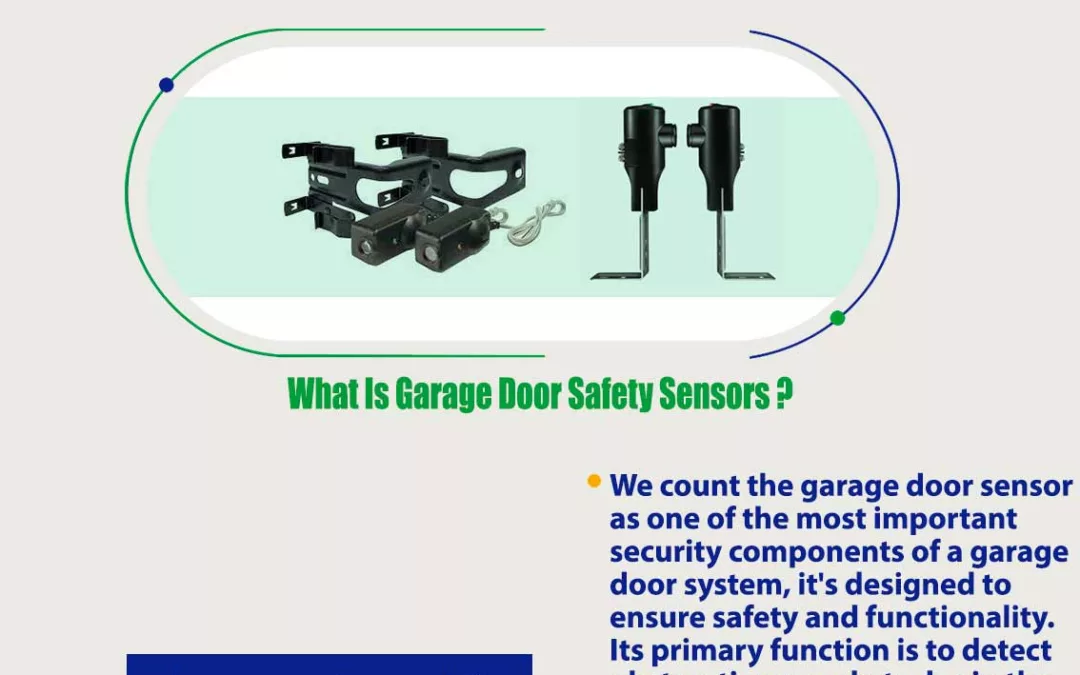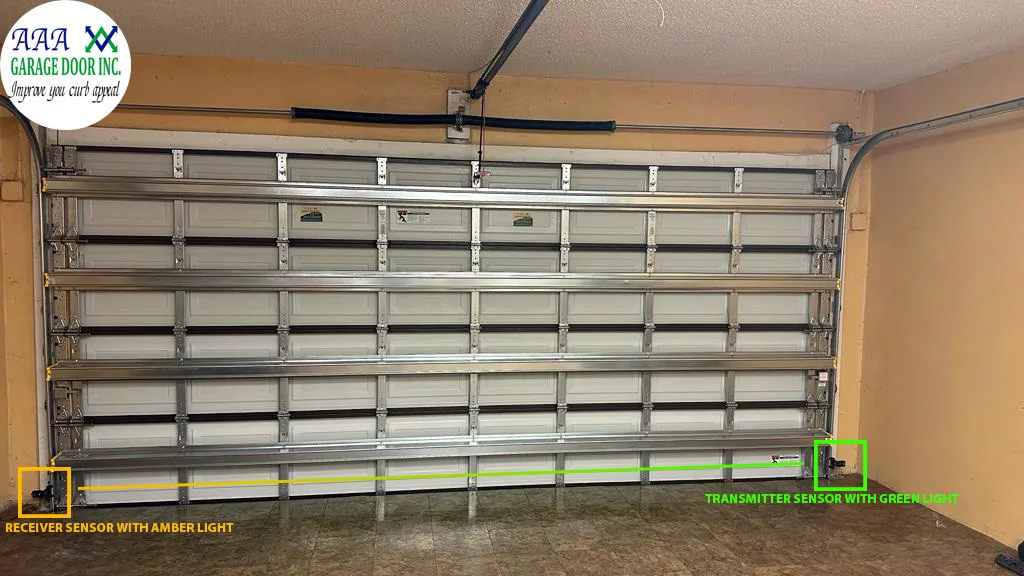
by Adam | Jul 7, 2023 | Garage Door Opener, Safety Sensors
We count garage door safety sensors as one of the most important security components of a garage door system, it’s designed to ensure safety and functionality. Its primary function is to detect obstructions or obstacles in the path of the closing garage door.
How Does The Garage Door Sensor Work?
Let’s explain this first in a simple form, the garage door sensor operates through the transmission and reception of infrared or laser beams. By detecting interruptions in the beam, it safeguards against accidents by prompting the door to reverse its movement, thus protecting both property and individuals.
Typically, a garage door sensor consists of two main parts: the transmitter and the receiver. These components are usually mounted on the sides of the garage door, near the bottom. The transmitter emits an infrared beam or laser across the doorway to the receiver, creating an invisible infrared line.
When the garage door is opening and closing, the receiver continuously monitors the infrared beam. If the beam remains unbroken, indicating that there are no obstructions, the garage door will continue its normal closing process. However, if the beam is interrupted or broken, it signifies the presence of an object in the door’s path, and the sensor triggers a safety mechanism.
Upon detection of an obstruction, the sensor immediately sends a signal to the garage door opener, instructing it to reverse the door’s movement. This prevents the door from closing on the object or person and avoids potential accidents or damages. The reversal mechanism can either stop the door’s movement entirely or prompt it to open back up, depending on the specific design of the garage door system.
In addition to the primary safety function, garage door sensors often have secondary features. Some models include a smart beam obstruction indicator, which alerts you with a notification sent to your phone if the sensor is interrupted, misaligned or the door reversed. This feature helps ensure the sensor functions correctly all the time and maintains optimal safety conditions to help monitor your door operations.
Where is the garage door safety sensor?
The garage door safety sensor is typically located near the bottom of the garage door tracks or at the wall beside the tracks, on both sides of the doorway.

Garage Door Sensors Receiver & Transmitter
To be more specific, according to Door & Access Systems Manufacturers Association (DASMA), garage door safety sensors should be installed no more than six inches above the floor. One sensor, known as the transmitter with green led light, is mounted on the right side of the door, while the other sensor, called the receiver with amber led light, is positioned on the left side.

Transmitter Garage Door Sensor
Do you need safety sensors for the garage door?
Yes, garage door safety sensors are essential components for garage doors, and their installation is highly recommended for enhanced safety and accident prevention.
That being said, all states, including Florida, have recognized the importance of garage door safety sensors and have implemented regulations to ensure their use. The U.S. Federal Law UL 325 requires all garage doors to include safety mechanisms, such as garage door sensors and all
AAA Garage Door Inc. is Based in our beloved Sunshine Florida State so we know that Florida building codes have required residential garage doors equipped with garage door openers manufactured in and forward 1993 to have an approved safety system, which typically includes safety sensors. These safety sensors are required to be installed and functioning properly to comply with the regulations.
Ultimately, regardless of specific legal requirements, it is highly recommended to install safety sensors for garage doors as they significantly contribute to the overall safety of the system, preventing accidents and protecting both property and individuals.
How long do garage door safety sensors last?
Since our operation, we found that most of the time garage door sensors can last for 4 to 5 years of use, sometimes more than that which only requires repairs and not a total replacement.
Do I need to upgrade my garage door safety sensors?
Upon mistakes and learning from them, products get better and better in avoiding the mistakes or malfunctions that manufacturers know about it, and that maximizes your security so we recommend replacing your garage door sensor as soon as you find a newer version released because after each new version release but for affordability solutions sometimes it’s okay to stay with your current safety sensors.
How do you Install garage door sensors?
These are the simple steps you need to install your garage door safety sensors
- UNPLUG THE GARAGE DOOR OPENER
- LOCATE THE SENSOR MOUNTING BRACKETS
- POSITION THE MOUNTING BRACKETS
- ATTACH THE BRACKETS
- ATTACH THE SENSORS TO THE BRACKETS
- CONNECT THE WIRES
- TEST THE SAFETY SENSORS
- ADJUST THE SENSORS
For more detailed steps please read our article about installing garage door sensors.
Remember, these steps provide a general guideline, and it is crucial to refer to the specific instructions provided with your garage door sensor kit. Additionally, if you are unsure about any aspect of the installation process, it is always advisable to seek professional assistance from a garage door company.
Living in Miami-dade or Broward Counties Our qualified garage door technicians are always ready to help you just give us a call at 305-702-0113. AAA Garage Door Inc. Is ready to help you with your garage door sensors installation right away.
How do I test my garage door safety sensors?
- Clear the garage door area: Make sure the garage door area is free from any obstructions, objects, or debris that could interfere with the sensor’s operation.
- Check the sensor alignment: Visually inspect the sensors to ensure they are properly aligned. The transmitter and receiver units should face each other directly, and there should be no physical obstructions blocking the path between them. then make sure of these 2 points: Your Sensors Are Wired Correctly
Making sure of the wires is important before your first time testing your garage door sensors so make sure you followed the correct wiring instruction from your opener manual. If your sensors are correctly wired you will find that the sensors led lights is active and not blinking or has weak lights. Your Green Led Light Is Lighting Solid
If you see that the green led light is blinking that indicates that your transmitter unit is not probably aligned to the receiver unit. To align your garage door safety sensors correctly you need first to make sure your sensors are at the same height and six inches from the floor then move your receiver unit until you find your transmitter unit led lights
- Close the garage door: Use the garage door opener or the control panel to activate the closing function of the garage door.
- Interrupt the sensor beam: As the garage door is in the process of closing, deliberately interrupt the sensor beam by placing an object, such as a cardboard box or a broomstick, between the sensors. Ensure that the object is positioned at the same height as the sensor beam.
- Observe the garage door’s response: If the safety sensors are functioning correctly, the garage door should immediately stop its downward movement and reverse its direction upon detecting the obstruction. You should hear the beeping sound after the garage door reverses completely.
- Remove the obstruction: Once you have confirmed that the sensors are working, remove the object that was blocking the sensor beam.
- Test the sensors again: Repeat the process by closing the garage door and placing an object in the sensor’s path. Verify that the door reverses its movement as expected.
- Clean the sensors: Over time, dust, dirt, or debris may accumulate on the sensors, affecting their performance. Regularly clean the sensors with a soft cloth to maintain their effectiveness.
Regularly testing your garage door safety sensors, ideally, once a month, helps ensure the continued safety of your garage door system. If you notice any issues or if the sensors do not function as expected during the testing process, it is recommended to consult our professional garage door technician for further inspection and maintenance.
Can garage door sensors be reversed?
Yes, you can reverse the garage door sensors to be the receiver sensor on the right side of the door and the transmitter sensor on the left side of the door but it’s not recommended except in rare For example but not limited like where the Receiving sensor is exposed to direct sunlight so the sunlight interferes with the infrared beam emitted to the transmitter sensors which causes the sensors to not function all the time probably.


by Adam | May 6, 2023 | Safety Sensors, GarageDoor
It is important to ensure your garage door safety for the protection of you and your family. One way to enhance the safety of your garage door is by installing safety reverse sensors. Safety sensors are a component of garage door systems, as they prevent the door from closing on a person, animal, or object. In this article, Learn the steps to install garage door safety sensors and keep your family and belongings secure. And FAQ for after & before installation to know even more.
Tools To Install Garage Door Safety Reverse Sensors
To get started, we’ll tell you the basic tools you’ll need for the installation process. Equipped with the right tools, you’ll be ready to embark on this rewarding project. Then, we’ll guide you through each step of the installation, providing clear instructions and valuable tips along the way.
- Screwdriver
- Drill
- Measuring tape
Steps to Install Garage Door Safety Reverse Sensors
Now that you have gathered all the necessary tools, let’s proceed with the installation process.
Choice the right garage door safety sensors
The first thing you need to do is to know that you can’t get a different safety sensors brand than your opener and expect it to work because it’s simply manufactured only to work on their brand garage door opener.
Living in Miami-Dade Or Broward Counties call us now at 305-702-0113. We are a Liftmaster Miami Authorized Dealer We match the excellence of our products with exceptional services (Repair – Installation – Replacement). Premium quality Local garage doors in Miami-Dade & Broward Counties, FL.
Unplug the Garage Door Opener
The first step is to unplug the garage door opener. you need to have no power running to the opener while you wiring the safety sensors.
Locate the Sensor Mounting Brackets
Locate the sensor mounting brackets that came with your Liftmaster & Chamberlain Safety Sensors kit. These brackets will be used to mount the sensors to the garage door track. Genie T-beam Sensors They have built-in brackets so you cant mount it on the door track.


Position the Mounting Brackets
Chamberlain opener’s safety reverse sensors usually come with a hook to mount the brackets at the door track if so Hook the mounting brackets on each side of the garage door track, approximately 6 inches above the floor.
Attach the Brackets
Genie Opener Safety T-Beams sensors come with screws. Using a drill, attach the brackets to the wall beside each side of your garage door. Make sure that the brackets are firmly secured.
Attach the Sensors to the Brackets
Mount the reverse safety sensor using the wind nut & bolt. Ensure that the sensors are level and facing each other. A common practice our technicians do after measuring the 6 inches and mounting the brackets, we use a measuring tape to ensure that both brackets are at the same height.
Connect the Wires
Connect the wires from the safety sensors to the garage door opener. Follow the instructions that came in your opener manual to correctly connect the wires.
Wire safety sensors to a Chamberlain garage door opener
Genie Openers Manual
Test the Safety Sensors
Once you have connected the wires, plug in the garage door opener and test the safety sensors. put an object in front of the sensors to check if they detect the obstruction and reverse the door’s motion. If the safety sensors are working correctly, the garage door will reverse its motion and hear a beeping sound. if your door didn’t reverse or stopped from closing that means your safety sensors not working it will be a good idea if you check the alignment of your sensor or check the wiring.
Adjust the Sensors
If the safety sensors are not working correctly, adjust their position or angle until they are correctly detecting obstructions. if your safety sensors still not working then you should call your local Garage door company
Common questions about garage door safety sensors
How does a garage door safety sensor work?
Garage door safety sensors have what’s called a photo-eye. The sensors use an infrared light beam, similar to your TV remote or your night vision camera. typically they are mounted no more than six inches off the ground. These two sensors indicated as a receiver with a green LED and a sender with an Amber or Red LED help create an invisible line across your garage door that detects when something is in the way.
Will any sensor work with any garage door opener?
No, not all garage door safety sensors will work with any garage door opener. While safety sensors generally operate on the same principle of detecting obstructions and signaling the opener to reverse the door’s direction, compatibility between the sensors and the specific garage door opener is essential. For instance, if you have a LiftMaster opener, sensors from Genie will not work with it, and vice versa.
Each manufacturer designs their sensors to be compatible specifically with their own line of garage door openers. The wiring configurations, communication protocols, and overall compatibility may differ between brands, making it crucial to use sensors that are specifically designed for your particular garage door opener brand. But don’t forget that Chamberlain Group Is a Parent company of LiftMaster which allows it to use there technology and components between them and that makes the LiftMaster & Chamberlain Safety Sensors compatible with each other openers.
Are Garage Door Safety Sensors Required?
Yes, garage door safety sensors are required by federal law in the United States. The U.S. Consumer Product Safety Commission (CPSC) specifically 16 CFR Part 1211 has implemented regulations to ensure the safety of residential garage door systems. According to the CPSC’s guidelines, all newly manufactured or installed automatic garage door openers must be equipped with a functioning safety reversing mechanism, commonly known as safety sensors. It’s important to note that complying with federal regulations by installing garage door safety sensors is not only a legal requirement but also a responsible and proactive step in ensuring the safety of your household. By investing in this crucial safety feature, you can significantly reduce the risk of accidents and protect your loved ones and property.
What are Garage Door Safety Sensors?
Safety sensors are a pair of sensors that are mounted on each side of the garage door near the floor. The receiver sensor with an Amber or Red LED sensor sends a beam of infrared light to the sending sensor with a green LED, creating an invisible barrier. If an object, person, or animal crosses this barrier while the door is closing, the sensors detect the obstruction and reverse the door’s motion. This is an important safety feature that can help prevent accidents and injuries.
Do installing Garage Door Safety Sensors Need a Professional?
For the sake of effectiveness, Yes, installing garage door safety sensors should be done by a professional garage door technician. Installing safety sensors yourself can lead to mistakes because it needs some knowledge of electrical wiring and mechanical system, which can compromise the effectiveness of the sensors. But if you have enough knowledge and follow your manual instructions, Installing the sensor will be an easy task to do.
What makes garage door safety sensors fail?
Several factors can contribute to the failure of garage door safety sensors. Here are some common reasons why garage door safety sensors may fail:
- Wrong Installation: Garage Door Sensors are only installed in their manufacturer brand which means you can’t get a garage door sensor from a brand and install it in another opener band.
- Wiring issues: Faulty or damaged wiring can interfere with the proper functioning of the safety sensors. Loose connections, frayed wires, or wiring that have been chewed by rodents can disrupt the signal transmission between the sensors and the garage door opener. It’s recommended to first inspect the wiring if you have an electrical problem with the sensors.
- Dirty or obstructed sensors: Dust, dirt, spider webs, or other debris can accumulate on the sensor lenses over time, obstructing the infrared beam. This can lead to false readings or failure to detect obstacles. Regularly cleaning the sensor lenses with a soft cloth can help prevent this issue.
Remember, if you prefer the assistance of professionals to install your garage door sensors which is recommended, our skilled technicians at AAA Garage Door Inc. are just a phone call away. Simply click to call us at 305-702-0113 to schedule an appointment and experience the excellence that has made us a trusted name in the industry. Serving Miami-Dade & Broward Counties








